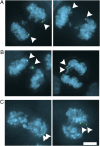Chromosome missegregation in human cells arises through specific types of kinetochore-microtubule attachment errors
- PMID: 21997207
- PMCID: PMC3207692
- DOI: 10.1073/pnas.1109720108
Chromosome missegregation in human cells arises through specific types of kinetochore-microtubule attachment errors
Abstract
Most solid tumors are aneuploid, and many missegregate chromosomes at high rates in a phenomenon called chromosomal instability (CIN). CIN reflects the erosion of mitotic fidelity, and it correlates with poor patient prognosis and drug resistance. The most common mechanism causing CIN is the persistence of improper kinetochore-microtubule attachments called merotely. Chromosomes with merotelic kinetochores often manifest as lagging chromosomes in anaphase, suggesting that lagging chromosomes fail to segregate properly. However, it remains unknown whether the lagging chromosomes observed in anaphase segregate to the correct or incorrect daughter cell. To address this question, we tracked the segregation of a single human chromosome during cell division by using LacI-GFP to target an integrated LacO array. By scoring the distribution of each sister chromatid during mitosis, we show that a majority of lagging chromosomes in anaphase segregate to the correct daughter cell. Instead, sister chromatids that segregate erroneously frequently do so without obvious evidence of lagging during anaphase. This outcome is expected if sister kinetochores on a chromosome bind microtubules oriented toward the same spindle pole, and we find evidence for syntelic kinetochore attachments in cells after treatments that increase missegregation rates. Thus, lagging chromosomes in anaphase are symptomatic of defects in kinetochore-microtubule attachment dynamics that cause chromosome missegregation associated with CIN, but the laggards rarely missegregate.
Conflict of interest statement
The authors declare no conflict of interest.
Figures




Similar articles
-
Anaphase spindle mechanics prevent mis-segregation of merotelically oriented chromosomes.Curr Biol. 2004 Dec 14;14(23):2149-55. doi: 10.1016/j.cub.2004.11.029. Curr Biol. 2004. PMID: 15589159
-
Merotelic kinetochores in mammalian tissue cells.Philos Trans R Soc Lond B Biol Sci. 2005 Mar 29;360(1455):553-68. doi: 10.1098/rstb.2004.1610. Philos Trans R Soc Lond B Biol Sci. 2005. PMID: 15897180 Free PMC article. Review.
-
Merotelic kinetochore orientation occurs frequently during early mitosis in mammalian tissue cells and error correction is achieved by two different mechanisms.J Cell Sci. 2003 Oct 15;116(Pt 20):4213-25. doi: 10.1242/jcs.00716. Epub 2003 Sep 2. J Cell Sci. 2003. PMID: 12953065
-
Merotelic kinetochore orientation versus chromosome mono-orientation in the origin of lagging chromosomes in human primary cells.J Cell Sci. 2002 Feb 1;115(Pt 3):507-15. doi: 10.1242/jcs.115.3.507. J Cell Sci. 2002. PMID: 11861758
-
Detection and correction of merotelic kinetochore orientation by Aurora B and its partners.Cell Cycle. 2007 Jul 1;6(13):1558-64. doi: 10.4161/cc.6.13.4452. Epub 2007 May 18. Cell Cycle. 2007. PMID: 17603301 Review.
Cited by
-
Role of chromosomal cohesion and separation in aneuploidy and tumorigenesis.Cell Mol Life Sci. 2024 Feb 22;81(1):100. doi: 10.1007/s00018-024-05122-5. Cell Mol Life Sci. 2024. PMID: 38388697 Free PMC article. Review.
-
Chromosomal instability in aneuploid acute lymphoblastic leukemia associates with disease progression.EMBO Mol Med. 2024 Jan;16(1):64-92. doi: 10.1038/s44321-023-00006-w. Epub 2023 Dec 15. EMBO Mol Med. 2024. PMID: 38177531 Free PMC article.
-
Methylglyoxal Impairs Sister Chromatid Separation in Lymphocytes.Int J Mol Sci. 2022 Apr 8;23(8):4139. doi: 10.3390/ijms23084139. Int J Mol Sci. 2022. PMID: 35456956 Free PMC article.
-
Nitro-Deficient Niclosamide Confers Reduced Genotoxicity and Retains Mitochondrial Uncoupling Activity for Cancer Therapy.Int J Mol Sci. 2021 Sep 27;22(19):10420. doi: 10.3390/ijms221910420. Int J Mol Sci. 2021. PMID: 34638761 Free PMC article.
-
An anaphase surveillance mechanism prevents micronuclei formation from frequent chromosome segregation errors.Cell Rep. 2021 Nov 9;37(6):109783. doi: 10.1016/j.celrep.2021.109783. Cell Rep. 2021. PMID: 34758324 Free PMC article.
References
-
- Lengauer C, Kinzler KW, Vogelstein B. Genetic instability in colorectal cancers. Nature. 1997;386:623–627. - PubMed
-
- Choi CM, et al. Chromosomal instability is a risk factor for poor prognosis of adenocarcinoma of the lung: Fluorescence in situ hybridization analysis of paraffin-embedded tissue from Korean patients. Lung Cancer. 2009;64:66–70. - PubMed
Publication types
MeSH terms
Grants and funding
LinkOut - more resources
Full Text Sources
Miscellaneous

